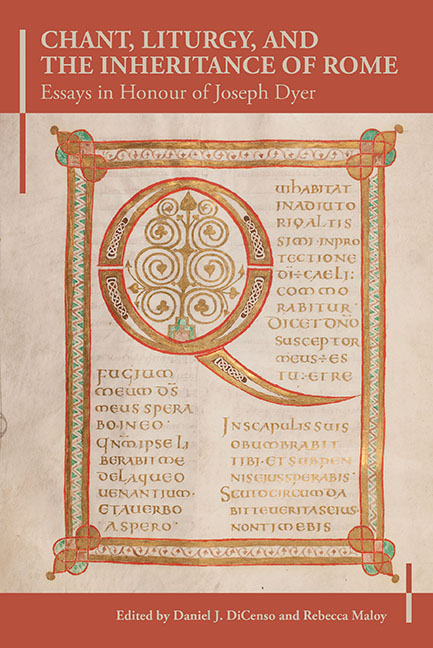Book contents
- Frontmatter
- Miscellaneous Frontmatter
- Contents
- List of Illustrations
- List of Tables
- List of Music Examples
- Notes on Contributors
- Preface
- Acknowledgements
- Abbreviations
- Part I Medieval Rome and Ancient Rites
- 1 Doxa en ipsistis Theo: Its Textual and Melodic Tradition in the ‘Missa graeca’
- 2 The Changing Roles of Old Saint Peter's in Late Antique and Early Medieval Rome
- 3 The Archdeacon, Power, and Liturgy before 1000
- 4 The Earliest Antiphons of the Roman Office
- 5 The Paschal Vigil in Medieval Rome
- 6 As the Bells Toll: Parish Proximity in Medieval Rome
- 7 The Moment of Scrutiny in the Missale Gallicanum Vetus and the Instruction of Catechumens in Merovingian and Carolingian Francia
- Part II The Liturgies of Italy
- Part III Books, Sources, and Reform in the Wake of Rome
- Part IV Roman Foundations: Later Liturgical Developments
- Publications by Joseph Dyer
- Index of Chant Incipits
- Index of Manuscripts
- General Index
5 - The Paschal Vigil in Medieval Rome
from Part I - Medieval Rome and Ancient Rites
Published online by Cambridge University Press: 14 June 2019
- Frontmatter
- Miscellaneous Frontmatter
- Contents
- List of Illustrations
- List of Tables
- List of Music Examples
- Notes on Contributors
- Preface
- Acknowledgements
- Abbreviations
- Part I Medieval Rome and Ancient Rites
- 1 Doxa en ipsistis Theo: Its Textual and Melodic Tradition in the ‘Missa graeca’
- 2 The Changing Roles of Old Saint Peter's in Late Antique and Early Medieval Rome
- 3 The Archdeacon, Power, and Liturgy before 1000
- 4 The Earliest Antiphons of the Roman Office
- 5 The Paschal Vigil in Medieval Rome
- 6 As the Bells Toll: Parish Proximity in Medieval Rome
- 7 The Moment of Scrutiny in the Missale Gallicanum Vetus and the Instruction of Catechumens in Merovingian and Carolingian Francia
- Part II The Liturgies of Italy
- Part III Books, Sources, and Reform in the Wake of Rome
- Part IV Roman Foundations: Later Liturgical Developments
- Publications by Joseph Dyer
- Index of Chant Incipits
- Index of Manuscripts
- General Index
Summary
The city of Rome and its religious practices have been an important aspect of Joseph Dyer's scholarship, and the clarity of his work might lead the unwary to imagine that it is easy to find out information about the liturgy of the city. After all, almost all books of the ‘Roman’ liturgy claim in principle to represent the practice of the city itself. More often than not, though, they represent aspects of the Roman liturgy as their scribes perceive it, mixed with a good measure of their local practice. This is what makes the study of manuscripts and of liturgy interesting, of course, but it creates special problems with regard to the city of Rome. In what follows, I have tried to gather the evidence that survives from Roman books themselves — books made for and used in the city of Rome — along with other material that has some bearing on the problem, in an attempt to sketch a single important moment in the liturgical year of the Roman church. I propose to consider Holy Saturday at about the time of our surviving liturgical manuscripts of the city, from the eleventh century to the codification of the liturgy in the thirteenth. I hope that this study may contribute something to an understanding of the problems involved in research on Rome and to a larger picture of the liturgical and ceremonial life of the city itself, as distinct from the Roman liturgy in the larger sense.
The study of any single day in Rome is a challenge, but Holy Saturday is particularly complex, because it is not one thing but many, and because it involves not a single ceremony but the activities of a whole city. The rites of Holy Saturday are many; even if we disregard the Divine Office, said on Holy Saturday as every other day, the solemn rites of the Paschal Vigil are an amalgam of ceremonies arising from different needs and at different times.
The Paschal Vigil has four elements, each of which deserves a study of its own, and some have received a lot of attention:
A. Introductory rite
Blessing of new fire
Praeconium paschale (Exultet)
B. Vigil: lections and prayers, with canticles
C. Baptisms
Examination of candidates
Procession to font
Blessing of water
Baptisms
Confirmation
Returning procession
D. The Mass of the Paschal vigil
- Type
- Chapter
- Information
- Chant, Liturgy, and the Inheritance of RomeESSAYS IN HONOUR OF JOSEPH DYER, pp. 143 - 188Publisher: Boydell & BrewerPrint publication year: 2017

